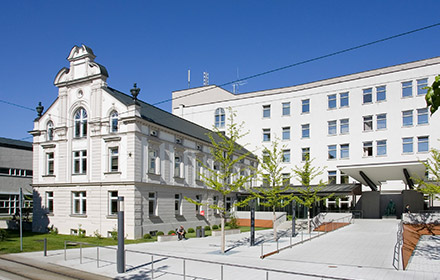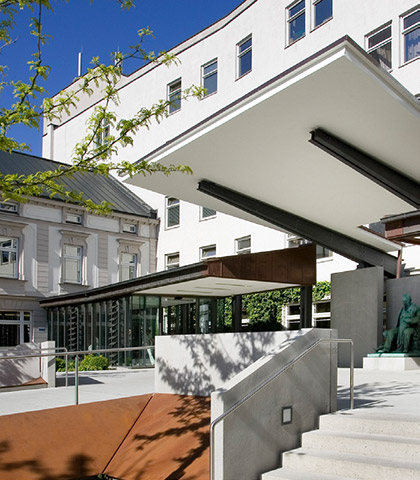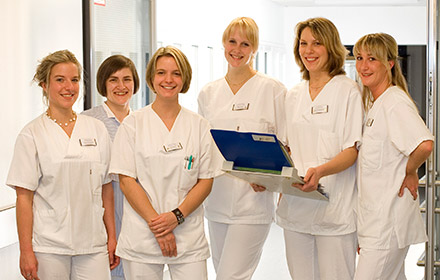NEC Display Solutions Client Installation Healthcare
HESSING FOUNDATION
IMPLEMENTING AN INTEGRATED QA SOLUTION FOR DIAGNOSTIC, MONITORING AND REPORTING
The role that a reliable screen representation plays in diagnosis and reporting is clear to every radiologist. In practice, however, quality control and proper monitor set-up are often neglected. Not by the Hessing foundation. The renowned healthcare provider relies on an integrated system from NEC Display Solutions.
The Hessing foundation belongs to the leading orthopaedic clinics in Germany. Over past decades various specialised clinics and specialist centres have developed from the former orthopaedic sanatorium in Augsburg-Göggingen. Due to the broad service that the Hessing foundation combines under one roof today, patients receive the best all round care.
The Challenge
Of course the accuracy of the diagnosis plays a central role in the clinic. The hospital management knows what significance the correct DICOM-compliant depiction of the CT and the X-Ray images has on the diagnostic monitors. An inaccurate representation can have fatal consequences in this area. Therefore a complete integrated solution was sought where the calibration of the monitors runs largely automatically. After an extensive evaluation of diagnostic screens from various manufacturers, NEC clearly came out ahead.

The NEC Solution
Today the facility dispenses with the typical diagnosis room to a large extent, allowing doctors to work with monitors at their own work place. Diagnostic screens stand on the desktops of orthopaedic surgeons and in the treatment rooms of the clinic. The MD213MG 3-megapixel grayscale model was chosen for about half of the 45 installed devices. These are used particularly in ambulances, but orthopaedic surgeons also prefer this type of monitor. For the other devices on the wards and in the medical rooms, the MD212MC 2-megapixel colour monitor was preferred.The display’s precise picture quality impressed the doctors in the Hessing clinic. “Small position markers on joint implants are clearly visible. The high image quality benefits us greatly in our daily work and gives us more certainty in examinations and post-operative treatment”, the head of department, Dr. Frank Pfeiffer, explains.
The majority of orthopaedic surgeons forego a configuration of two monitors, where an RIS-monitor and a high-resolution instrument for the diagnosis would be needed. The MD212MC, with its excellent visual and ergonomic features, is well suited for both purposes alike. Brightness levels that far exceed those of conventional office monitors, an extremely wide viewing angle and an anti-glare screen surface allow the monitor to excel both in office applications as well as during the examination.
In addition, as a result of using a single device there is considerably more space left on the desktop - an advantage that makes itself noticed everyday in many practical ways: “As a doctor, you can look straight in the eyes of a patient, instead of having to conceal yourself behind a screen wall”, one radiologist describes the benefits.

In order to meet the statutory requirements, a consistency check of the monitors is carried out every three to six months depending on ambient light conditions. This check is dictated by the quality assurance directives (QS-RL) required by § 17 of the German X-ray Ordinance and must be documented together with their results for secure auditing. Until now, all these test results were collected via laptop and stored in Excel files, a laborious task, and far from ideal when the medical authorities requested the rapid retrieval of comprehensive data.
“We looked for a total quality assurance system, which could centrally store the results of this examination, and needed an intelligent method for that”, Markus Mayer, the head of medical technology, describes the selection process. “Due to quicker processing, such a solution should fit into the working procedures of the hospital without keeping the doctors from their work too long”.
For this purpose the NEC partner at this installation, the Bechtle IT systems company, provided the NEC GammaCompMD QA server, which can remotely provide automatic adjustments and start the DICOM conformity tests for diagnostic monitors. Furthermore, this solution can monitor data such as operating time, the remaining operating time and current luminance data.
The remote adjustment functions via an ingenious system: the server sends a command to the screen which can be re-adjusted independently over a front sensor integrated into the panels. This device checks both the luminance and the DICOM gamma curve. But with this solution alone the consistency tests cannot be performed in accordance with QS-RL. For this reason the clinic implemented a QAXRAY solution from the Berlin company, Diraal in cooperation with NEC. This makes it possible to implement a quality assurance system, which corresponds to the German QS-RL rules. All the test results are stored on a central server. “These may be submitted to the medical authority responsible for review at any time,” explains Norbert Funk, who guided the introduction of the system as a project manager at NEC.

Part of this QA system is also the daily visual inspection of the image representation findings on the individual screens. This must be carried out by the doctors, when they check, using a so-called SMPTE test image, whether all details are recognisable on them. The answers given are logged in the process, and when collected can also be handed over on request to the medical authorities.
The Result
The implementation of the complete system was concluded in November 2010 and also included the prescribed acceptance testing of the monitors, with entry of the data and reference values for the consistency checks into the QAXRAY system. “Meanwhile we have operated QAXRAY for six months and performed consistency testing. In addition to halving the test time per screen compared to the previous method, the central archiving of the test reports is a critical advantage. The results confirm our choice of NEC and speak for the quality of the overall solution”, explains Markus Karlshöfer, who as a medical technician performs the consistency checks himself and manages the QAXRAY system.

